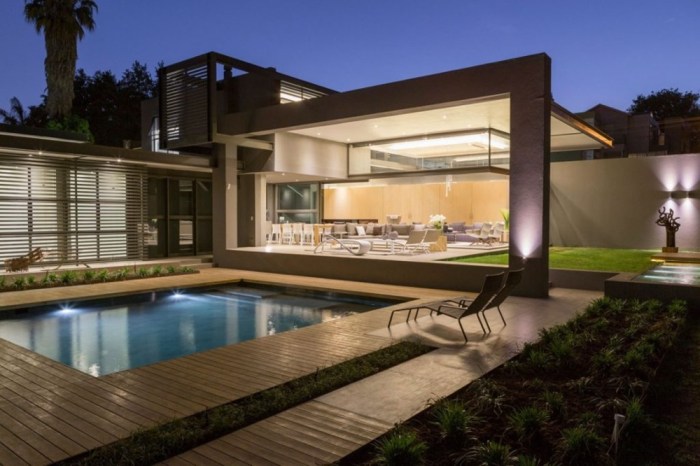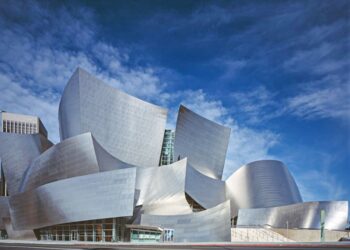Embark on a journey through the world of modern home design ideas by top architects, where innovation meets functionality and aesthetics. This captivating topic explores the evolution of architectural trends that shape our living spaces.
Delve into the elements, sustainability features, technology integration, architectural styles, and interior design trends that define modern homes today.
Introduction to Modern Home Design Ideas
Modern home design refers to the architectural style that emphasizes simplicity, functionality, and clean lines. It often incorporates innovative materials and technologies to create spaces that are both aesthetically pleasing and practical.
Architects play a crucial role in modern home design as they are trained professionals who have the expertise to translate a homeowner's vision into a reality. They are responsible for integrating the latest trends and technologies into the design process while ensuring that the final product meets the client's needs and preferences.
The Importance of Incorporating Innovative Ideas in Modern Home Design
Innovation is essential in modern home design as it allows architects to push the boundaries of traditional design concepts and create unique, personalized spaces for their clients. By incorporating innovative ideas, architects can enhance the functionality, sustainability, and overall aesthetic appeal of a home.
Elements of Modern Home Design
Modern home design incorporates several key elements that set it apart from traditional design styles. Architects utilize light, materials, and space in innovative ways to create functional and aesthetically pleasing living spaces.
Light
Architects in modern home design often prioritize natural light, aiming to bring the outdoors inside. Large windows, skylights, and open floor plans are common features that allow ample light to filter through the space. Artificial lighting is also carefully considered, with designers using a mix of ambient, task, and accent lighting to create different moods and highlight architectural elements.
Materials
Modern home design favors the use of industrial materials such as steel, glass, and concrete. These materials are not only durable and low maintenance but also lend a sleek and contemporary look to the space. Designers often combine contrasting materials to create visual interest and texture, such as pairing warm wood with cool metal accents.
Space
In modern home design, architects prioritize open and flexible spaces that promote flow and connectivity. Rooms are often interconnected, with minimal partitions to create a sense of expansiveness. Multi-functional spaces are also common, allowing homeowners to adapt rooms for different uses and activities.
Additionally, designers pay attention to spatial planning to ensure efficient use of every square foot, maximizing storage options and optimizing traffic flow within the home.
Sustainable Features in Modern Home Design
When it comes to modern home design, sustainability plays a crucial role in creating a greener and more environmentally friendly living space. Architects and designers are increasingly incorporating sustainable features into their designs to reduce the carbon footprint of buildings and promote eco-friendly practices.
Eco-Friendly Materials and Technologies
Modern homes often utilize a variety of eco-friendly materials and technologies to enhance sustainability. Some examples include:
- Bamboo flooring: Bamboo is a fast-growing and renewable resource that makes an excellent alternative to traditional hardwood floors.
- Solar panels: Solar energy is a clean and renewable source of power that can help reduce electricity bills and reliance on non-renewable energy sources.
- Green roofs: Green roofs are covered with vegetation, which helps reduce stormwater runoff, improve air quality, and provide insulation for the building.
- Energy-efficient appliances: Energy-efficient appliances consume less electricity, reducing energy waste and lowering utility costs.
Integration of Sustainability in Designs
Architects integrate sustainability into their designs in various ways, such as:
- Passive solar design: Orienting the building to maximize natural light and heat gain, reducing the need for artificial lighting and heating.
- Proper insulation: Using high-quality insulation materials to minimize heat loss and maintain a comfortable indoor temperature without excessive energy consumption.
- Water-saving fixtures: Installing low-flow toilets, faucets, and showerheads to conserve water and reduce water wastage.
- Recycled materials: Incorporating recycled materials into the construction process to reduce waste and minimize the environmental impact of building materials.
Technology and Automation in Modern Home Design

Technology and automation play a crucial role in shaping modern home design, offering convenience, efficiency, and sustainability to homeowners.
Smart Home Features
Architects are incorporating various smart home features into modern home designs to enhance the overall living experience. Some common smart home features include:
- Smart thermostats that adjust temperature settings based on usage patterns and preferences.
- Automated lighting systems that can be controlled remotely through smartphones or voice commands.
- Home security systems with cameras and sensors that provide real-time monitoring and alerts.
- Integrated entertainment systems that allow for seamless access to music, movies, and streaming services throughout the home.
Impact of Automation
Automation has significantly impacted modern home design by revolutionizing the way we interact with our living spaces. Some key impacts of automation on modern home design include:
- Increased energy efficiency through smart appliances and lighting systems that optimize usage and reduce waste.
- Enhanced security and safety with advanced surveillance cameras, smart locks, and motion sensors that provide round-the-clock protection.
- Improved convenience and comfort with automated systems that can be customized to suit individual preferences and schedules.
- Greater sustainability by promoting eco-friendly practices such as water conservation, energy monitoring, and waste reduction.
Innovative Architectural Styles in Modern Home Design
In today's modern home design landscape, architects are constantly pushing the boundaries of traditional styles to create innovative and unique architectural designs. These styles not only enhance the aesthetic appeal of the home but also incorporate functionality and sustainability.
Fusion of Architectural Styles
In modern home design, architects often blend different architectural styles to create a cohesive and visually appealing look. This fusion of styles can range from mixing contemporary elements with traditional ones to combining industrial and minimalist designs. By merging these styles, architects create homes that stand out and offer a fresh take on modern living.
Iconic Modern Home Designs
Renowned architects have left their mark on modern home design with iconic structures that showcase innovative architectural styles. From Frank Lloyd Wright's Fallingwater to Zaha Hadid's Heydar Aliyev Center, these designs push the boundaries of what is possible in architecture.
These homes not only serve as functional spaces but also as works of art that inspire and captivate.
Sustainable Architectural Features
In addition to blending styles, modern home design also focuses on incorporating sustainable features. Architects are integrating green technologies such as solar panels, passive heating and cooling systems, and rainwater harvesting into their designs. These sustainable elements not only reduce the environmental impact of the home but also enhance its overall efficiency and comfort.
Interior Design Trends in Modern Homes
Interior design plays a crucial role in modern homes, creating functional yet aesthetically pleasing spaces that cater to the needs and preferences of the residents. Architects carefully consider various elements such as color, texture, and furniture to enhance the overall look and feel of the interiors.
Use of Minimalist Design
Minimalist design is a popular trend in modern homes, focusing on simplicity, clean lines, and a clutter-free environment. Architects often use neutral colors, sleek furniture, and strategic lighting to create a sense of openness and tranquility in the interiors.
Incorporation of Natural Elements
Bringing the outdoors inside is another trend in modern interior design, with architects incorporating natural elements such as wood, stone, and greenery to add warmth and texture to the space. This biophilic design approach promotes a connection to nature and enhances the overall ambiance of the home.
Emphasis on Sustainable Materials
Sustainability is a key consideration in modern interior design, with architects opting for eco-friendly materials such as recycled wood, bamboo, and low VOC paints. These sustainable choices not only reduce the environmental impact but also contribute to a healthier indoor living environment.
Integration of Smart Technology
Technology and automation play a significant role in modern home interiors, with architects incorporating smart features such as programmable lighting, temperature control systems, and integrated sound systems. These tech-savvy additions enhance convenience, comfort, and efficiency in the home.
Play with Textures and Patterns
Architects experiment with textures and patterns to add visual interest and depth to modern home interiors. From textured walls and statement flooring to bold patterns on textiles and decor, these design elements create a dynamic and inviting space that reflects the personality of the residents.
Final Conclusion
In conclusion, modern home design ideas by top architects offer a harmonious blend of creativity and practicality, transforming houses into modern marvels. Explore the endless possibilities and create your dream living space with inspiration from these architectural masterminds.
FAQ
How do architects incorporate sustainability into modern home design?
Architects integrate sustainability by using eco-friendly materials, energy-efficient technologies, and designing spaces that maximize natural light and ventilation.
What are some popular interior design trends in modern homes?
Popular interior design trends include minimalist aesthetics, open floor plans, sustainable materials, and the use of neutral colors with pops of bold accents.
How do architects blend different architectural styles in modern home design?
Architects blend different styles by incorporating elements from various architectural movements while maintaining a cohesive and contemporary overall look.






